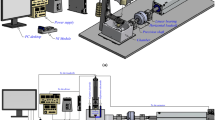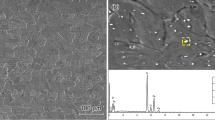Abstract
The effects of different electrochemical potentials on the tribocorrosive behaviour of AISI 420 in simulated body fluid (37 °C, 0.15 M NaCl solution) were studied, using a ball-on-disc tribometer under potentiostatic control. Results indicated a strong dependence of the material loss and degradation mechanisms on the applied potential. Cathodic polarization led to the lowest material loss, which was attributed to the electrochemical removal and mechanical destruction of the passive layer, resulting in a low corrosive degradation and strong adhesion. During polarization at the equilibriums between cathodic and anodic reactions, maximum material loss was observed. This was attributed to galvanic coupling between the wear track and the surrounding surface, which resulted in a high electrochemical degradation, that was maintained by continuous mechanical destruction of the passive layer. At potentials in the passive region, a lower material loss was observed. This is considered to be caused by faster repassivation and higher stability of the passive layer, which inhibits electrochemical degradation and impedes the formation of adhesion contacts. According to the results, the greatest material destruction occurs in between cathodic or anodic polarisation, which is common during the use of products like surgical instruments.









Similar content being viewed by others
Data Availability
All data generated or analysed during this study are included in this published article.
References
Landolt D, Mischler S (2011) Tribocorrosion of passive metals and coatings. Woodhead Publishing Limited, Cambridge
Yan Y (2013) Bio-tribocorrosion in biomaterials and medical implants. Woodhead Publishing Limited, Cambridge
Menezes PL, Ingole SP et al (2013) Tribology for scientists and engineers. Springer, New York
Wood R (2007) Tribo-corrosion of coatings: a review. J Phys D Appl Phys. https://doi.org/10.1088/0022-3727/40/18/S10
Dalmau A, Richard C, Igual-Munoz A (2018) Degradation mechanisms in martensitic stainless steels: wear, corrosion and tribocorrosion appraisal. Tribol Int 121:167–179. https://doi.org/10.1016/j.triboint.2018.01.036
Mischler S, Spiegel A, Landolt D (1999) The role of passive oxide films on the degradation of steel in tribocorrosion systems. Wear 225–229:1078–1087. https://doi.org/10.1016/S0043-1648(99)00056-3
Yin C, Liang Y, Jiang Y, Yang M, Long S (2017) Formation of nano-laminated structures in a dry sliding wear-induced layer under different wear mechanisms of 20CrNi2Mo steel. Appl Surf Sci 423:305–313. https://doi.org/10.1016/j.apsusc.2017.06.187
Dalmau A, Rmili W, Richard C, Igual-Munoz A (2016) Tribocorrosion behavior of new martensitic stainless steels in sodium chloride solution. Wear 368–369:146–155. https://doi.org/10.1016/j.wear.2016.09.002
Boese E, Röthig J, Garz I, Schmidtchen H (1998) Tribokorrosion von nichtrostenden Stählen. Mater Corros 49:98–107. https://doi.org/10.1002/(SICI)1521-4176(199802)49:2%3C98::AID-MACO98%3E3.0.CO;2-7
Watson SW, Friedersdorf FJ, Madsen BW, Cramer SD (1995) Methods of measuring wear-corrosion synergism. Wear 181–183:476–484. https://doi.org/10.1016/0043-1648(95)90161-2
Mischler S (2008) Triboelectrochemical techniques and interpretation methods in tribocorrosion: A comparative evaluation. Tribol Int 41:573–583. https://doi.org/10.1016/j.triboint.2007.11.003
Zhang BB, Wang JZ, Zhang Y, Han GF, Yan FY (2017) Tribocorrosion behavior of 410SS in artificial seawater: effect of applied potential. Mater Corros 68:295–305. https://doi.org/10.1002/maco.201609119
Olsson COA, Landolt D (2003) Passive films on stainless steels - chemistry, structure and growth. Electrochim Acta 48:1093–1104. https://doi.org/10.1016/S0013-4686(02)00841-1
Sun Y, Rana V (2011) Tribocorrosion behaviour of AISI 304 stainless steel in 0.5 M NaCl solution. Mater Chem Phys 129:138–147. https://doi.org/10.1016/j.matchemphys.2011.03.063
Zhang B, Wang J, Zhang Y, Han G, Yan F (2016) Comparison of tribocorrosion behaviour between 304 austenitic and 410 martensitic stainless steels in artificial seawater. RSC Adv 6:107933–107941. https://doi.org/10.1039/C6RA18497A
Bidiville A, Favero M, Stadelmann P, Mischler S (2007) Effect of surface chemestry on the mechanical response of metals in sliding tribocorrossion systems. Wear 263:207–217. https://doi.org/10.1016/j.wear.2007.01.066
Sun Y, Haruman E (2011) Effect of electrochemical potential on tribocorrosion behavior of low temperature plasma carburized 316L stainless steel in 1 M H2SO4 solution. Surf Coat Technol 205:4280–4290. https://doi.org/10.1016/j.surfcoat.2011.03.048
Huttunen-Saarivirta E et al (2016) Tribocorrosion study of martensitic and austenitic stainless steels in 0.1 M NaCl solution. Tribol Int 95:358–371. https://doi.org/10.1016/j.triboint.2015.11.046
Gassner A et al (2021) Tribocorrosion mechanisms of martensitic stainless steels. HTM J Heat Treat Mater 76:205–218. https://doi.org/10.1515/htm-2021-0004
Greenish S et al (2002) Measurement, analysis and display of haptic signals during surgical cutting. Presence 11:626–651. https://doi.org/10.1162/105474602321050749
McCafferty E (2010) Introduction to corrosion science. Springer, New York
Diomidis N, Celis JP, Ponthiaux P, Wenger F (2009) A methodology for the assessment of the tribocorrosion of passivating metallic materials. Lubr Sci 21:53–67. https://doi.org/10.1002/ls.73
Dalbert V et al (2019) The effects of microstructures and repassivation kinetics on the tribocorrosion resistance of ferrite and ferrite-martensite stainless steels. Wear 420–421:245–256. https://doi.org/10.1016/j.wear.2018.10.023
Favero M, Stadelmann P, Mischler S (2006) Effect of the applied potential of the near surface microstructure of a 316L steel submitted to tribocorrosion in sulfuric acid. J Phys D Appl Phys 39:3175–3183. https://doi.org/10.1088/0022-3727/39/15/S07
Grzeskiewicz R (1988) Effect of hydrogen on the coefficient of friction of iron. Virginia Polytechnic Institute and State University, Blacksburg
Pokhmurs’kyi VI, Vasyliv KB (2012) Influence of hydrogen on the friction and wear of metals (a survey). Mater Sci 48:125–138. https://doi.org/10.1007/s11003-012-9482-1
Siddiqui RA, Abdullah HA (2005) Hydrogen embrittlement in 0,31 % carbon steel used for petrochemical applications. J Mater Process Technol 170:430–435. https://doi.org/10.1016/j.jmatprotec.2005.05.024
Kheradmand N et al (2016) Effect of hydrogen on the hardness of different phases in super duplex stainless steel. Int J Hydrogen Energy 41:704–712. https://doi.org/10.1016/j.ijhydene.2015.10.106
Haupt S, Strehblow HH (1995) A combined surface analytical and electrochemical study of the formation of passive layers on Fe/Cr alloys in H2SO4. Corros Sci 37:43–54. https://doi.org/10.1016/0010-938X(94)00104-E
Liu Z (2018) Microstructure evolution under tribological loading and its elementary mechanisms. Karlsruher Institut für Technologie Fakultät Maschinenbau. https://doi.org/10.5445/IR/1000085322
Battaile CC et al (2012) The hardness and strength of metal tribofilms: an apparent contradiction between nanoindentation and pillar compression. Acta Mater 60:1712–1720. https://doi.org/10.1016/j.actamat.2011.11.059
Wang Y, Lei T, Liu J (1999) Tribo-metallographic behavior of high carbon steels in dry sliding—III. Dynamic microstructural changes and wear. Wear 231:20–37. https://doi.org/10.1016/S0043-1648(99)00117-9
Sikorski ME (1963) Correlation of the coefficient of adhesion with various physical and mechanical properties of metals. J Basic Eng. https://doi.org/10.1115/1.3656577
Sikorski ME (1964) The adhesion of metals and factors that influence it. Wear 7:144–162. https://doi.org/10.1016/0043-1648(64)90050-X
Mokhtar MOA, Zaki M, Shawki GSA (1980) Correlation between the frictional behaviour and the physical properties of metals. Wear 65:29–34. https://doi.org/10.1016/0043-1648(80)90004-6
Stott FH, Wood GC (1978) The influence of oxides on the friction and wear of alloys, Veröffentlichung. Tribol Int. https://doi.org/10.1016/0301-679X(78)90178-0
Anantha KH et al (2017) In situ AFM study of localized corrosion processes of tempered AISI 420 martensitic stainless steel: effect of secondary hardening. J Electrochem Soc 164:810–818. https://doi.org/10.1149/2.1261713jes
Anantha KH (2018) An experimental study to understand the localized corrosion and environment assisted cracking behavior of AISI 420 martensitic stainless steel. KTH Royal Institute of Technology, Stockholm
Funding
There were no research grants from any funding agencies for this work.
Author information
Authors and Affiliations
Corresponding author
Ethics declarations
Conflict of interest
The authors have no relevant financial or non-financial interests to disclose.
Additional information
Publisher's Note
Springer Nature remains neutral with regard to jurisdictional claims in published maps and institutional affiliations.
Rights and permissions
About this article
Cite this article
Gassner, A., Conzelmann, A., Palkowski, H. et al. Effect of Electrochemical Potential on Tribocorrosion Behaviour of AISI 420. J Bio Tribo Corros 8, 80 (2022). https://doi.org/10.1007/s40735-022-00682-0
Received:
Revised:
Accepted:
Published:
DOI: https://doi.org/10.1007/s40735-022-00682-0




